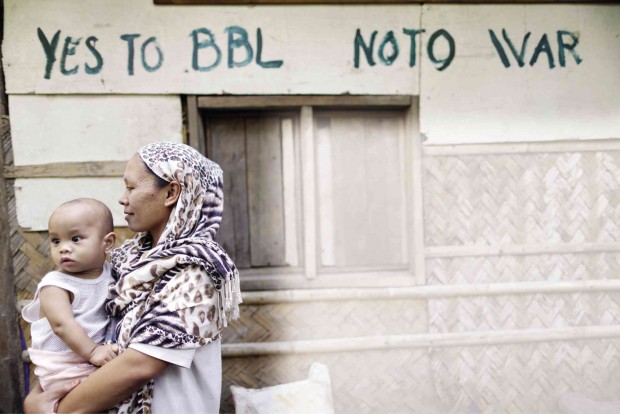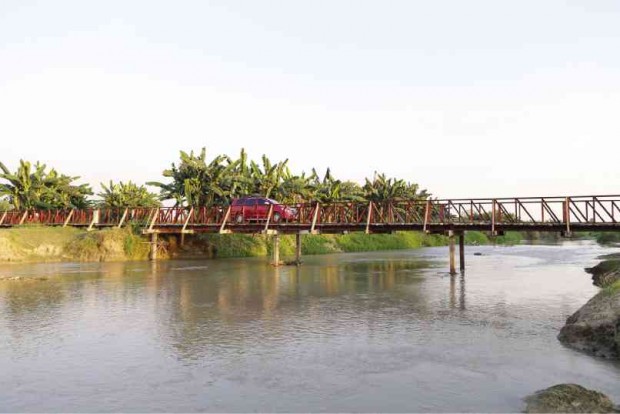‘Oplan Exodus’ vs Marwan missed antiterror lessons

WRITING ON THE WALL Graffiti painted on a wall in the village of Tukanalipao in Mamasapano town, Maguindanao province, expresses the sentiments of residents of the site of the slaughter of 44 Special Action Force commandos who were sent on a mission to capture international terrorist Marwan on Jan. 25 last year. The slaughter set back the government’s timetable for the peace process with the Moro Islamic Liberation Front. PHOTOS BY JEOFFREY MAITEM/INQUIRER MINDANAO
(Last of two parts)
CAGAYAN DE ORO CITY—Over the last decade, the protracted peace negotiations between the government and the Moro Islamic Liberation Front (MILF) have been replete with lessons on the conduct of counterterrorism initiatives in the context of an insurgency that is in the process of being resolved.
In May 2008, the Brussels-based International Crisis Group (ICG) came out with the report titled “Counter-Insurgency vs Counter-Terrorism in Mindanao” that looked into the merits of the Ad Hoc Joint Action Group (Ahjag) as a mechanism to fight terrorism.
The report, which ICG said is “based on extensive interviews in Mindanao, Sulu, Basilan and Manila in 2007 and 2008,” was partly a critique of the US government’s Operation Enduring Freedom-Philippines that targeted the Sulu-based al-Qaida-linked Abu Sayyaf Group (ASG) as part of its so-called Global War on Terror after the 9/11 attacks in New York.
ICG cited the Ahjag for its success in expelling key figures of the ASG out of mainland Mindanao in 2005 while avoiding “accidental clashes” between pursuing government forces and MILF rebels.
This was after the MILF agreed to cooperate with Philippine authorities, upon the prodding of the US government, in going after top ASG figures suspected to be lurking in its strongholds and threatening to spread terrorism in Central Mindanao. (In turn, the United States stepped up its behind-the-scenes role in helping move forward the peace negotiations between the MILF and the government.)
The ICG noted that for more than two years, the Ahjag “helped prevent conflict from escalating in the MILF’s heartland as Philippine forces searched for terrorists,” as well as “forced key ASG and jihadi targets back into their corner on Jolo” where they were hunted down.
The 2008 ICG report said the government-MILF cooperation “prompted the MILF’s leadership to discipline its own extremists who were harbouring jihadis” in a demonstration of rebel chief Murad Ebrahim’s “willingness to control extremists in his own fold.”
The Jakarta-based Institute for the Policy Analysis of Conflict (Ipac) shared the same view.
That international terrorist Zulkifli bin Hir, alias Marwan, was on the run since 2005 “shows clearly how MILF leaders rejected the presence of foreign jihadists and tried to ban activities that could threaten negotiations,” read the Ipac report, “Killing Marwan in Mindanao.”
“They were not always successful and there were occasionally rogue commanders who provided refuge and other forms of support, but the message was clear that terrorists were not welcome,” it added.
Chaff and grain
Even if Ahjag did not result in the terrorists’ capture, the ICG said the cited outcomes were already good enough for a mechanism that was still a work-in-progress.
Its 2008 report recommended the setup of a similar mechanism with the Moro National Liberation Front (MNLF) in Sulu where the operations against the ASG, it observed, tend to lump insurgents and terrorists together.
The ICG said a similar mechanism “is needed there (in Sulu) as the fugitives disappear into MNLF territory.”
“Mass-based insurgencies like the MILF and MNLF rely on supportive populations. By extension, small numbers of terrorists rely on sympathetic insurgents,” the ICG observed.
“Counterterrorism’s central task in a setting like that in the Philippines is to isolate jihadis from their insurgent hosts—not divide insurgents from the population,” it pointed out. “Where distinguishing between insurgents and terrorists is possible, encouraging the first to cooperate against the second, rather than collude with them, must be a central pillar of counter-terrorism programs.”
With respect to the MILF, Ahjag was the mechanism to achieve that cooperation. Ipac asserts: “Without the MILF’s active involvement, no long term solution to extremism in the Philippines is thinkable.”
Lessons not learned
Absence of prior coordination with the MILF in the conduct of law enforcement actions has proven to be fatal in the past, not only for the security forces but also for civilian communities and the general atmosphere of the peace process.
Such sorry outcomes are the principal reason the Ahjag was designed to avoid.
One example is the July 10, 2007, encounter between MILF rebels and troops of the Philippine Marines in Al-Barka, Basilan, that resulted in the death of 23 soldiers, some of whom were later beheaded by ASG forces. The government forces were then searching for kidnapped Italian priest Giancarlo Bossi.
Another instance was in October 2011 when 19 neophyte Scout Rangers were killed, also in Al-Barka, when they engaged MILF forces who were surprised at their presence. The government troops were out to arrest a suspected ASG leader who is also an MILF commander.
In both incidents, the peace process came out bruised by calls for another war against the MILF, and soured, to a certain extent, the atmosphere for negotiations.
In July 2004, when work to make operational the Ahjag was still underway, an ICG briefer emphasized: “Attempts to move directly against terrorists embedded in MILF-controlled territory risk an escalation of violence and a breakdown of talks.”
“Yet without a successful peace agreement, the region will continue to be marked by a climate of lawlessness in which terrorism can thrive,” it added.
The ICG dubbed this “the central paradox” of the peace process with Moro rebels.
If Ahjag had worked in the past when the government and the MILF were still in the thick of negotiations, how come the Special Action Force (SAF) command thought it won’t be helpful for the Mamasapano operation when the parties already forged a peace pact and have considered each other as partners?

MOTORISTS cross a new steel bridge that took the place of one in Tukanalipao village, Mamasapano town, that became infamous for being the site where many of the SAF 44 commandos were killed.
Blown-up image
Ipac partly attributes this to a distorted view of who Marwan really is.
It challenged the characterization of Marwan as some big catch. Saying it interviewed five Indonesians who knew Marwan and his activities in Indonesia and the Philippines, it stood that he “was not the world-class terrorist he was made out to be” but rather “a snake who has been blown up into a dragon.”
This was helped in large measure by the US government’s Rewards for Justice Program, which tagged a $5-million price for Marwan.
Ipac debunked the description by then SAF commander Getulio Napeñas of Marwan during the Feb. 9, 2015, Senate hearing as “the most notorious bomb expert not just here in Southeast Asia but also in the entire world.” It said Marwan only had “some rudimentary bomb-making skills” gained through his involvement in the sectarian conflict in Maluku, Indonesia, in 2000.
In that same Senate hearing, Napeñas also referred to Marwan as one of the “technical masterminds behind the 2002 Bali bombing,” which Ipac said was “erroneous” because “in any case (he) was already in the Philippines” when this happened.
But Ipac said Marwan “was a source of funds and equipment for friends in both the MILF and the ASG, and he unquestionably aided and abetted terrorist attacks.”
It said Marwan could have been mistakenly characterized as a big fish because he was associated with the “major players,” like Umar Patek and Dulmatin. “The more times he was declared dead and then proved to be alive, the more dangerous he seemed to become.”
“(Thus) it became imperative to get this man who had grown into a monster that for the security forces involved, it was apparently worth bypassing the (peace) mechanisms …,” Ipac explained.
Imperative of peace
Achieving peace with Moro rebels is the only lasting solution to denying Southeast Asian terrorists a sanctuary in Mindanao as well as ending the social condition that spawns radicalization.
Washington-based Center for Strategic and International Studies (CSIS) noted that the growth of regional terrorist networks like Jemaah Islamiyah (JI) partly owes to the “outbreak and escalation of conflict” in the Asian neighborhood.
“The war against the Soviets in Afghanistan, sectarian conflicts in Indonesia, and violence in the southern Philippines were crucial to radicalizing, training and mobilizing the JI network,” said a November 2011 report that examined the historical development and future prospects for al-Qaida and its associated movements.
“The most likely combat opportunities for JI operatives in the future are the insurgencies in the southern Philippines, southern Thailand and Burma (Myanmar), or a fresh round of sectarian bloodshed in Indonesia. Significant involvement in these conflicts could reinvigorate JI,” said the report, which was authored by David Gordon and Samuel Lindo.
“The most violent and active JI splinters will probably remain anchored in the ungoverned corners of southern Philippines,” it further said.
It, however, hoped then that a positive outcome of the peace process between the government and the MILF will render their Mindanao safe haven “unviable.”
But the missteps in the Mamasapano operation dealt a heavy blow to the peace process in Mindanao, creating sociopolitical crevices that can be filled by the dangerous seeds of extremism which can threaten the country and its Southeast Asian neighbors.
Marwan could be laughing in his grave.